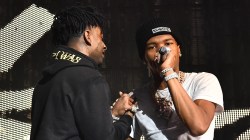Ten years ago BET and MTV were trying to figure out how to fit Hip Hop videos within their already crowded programming schedule. At some point they stopped caring, because they could make more of a profit by showing reality shows all day. Since then, the Internet has given us sites like YouTube, Vimeo and HipHopDX, where you can catch up on the latest visuals without having to sit through five different tampon commercials.
One of the men responsible for the change in how and where we watch videos is John Colombo. His model allows artists to release as many quality videos as they want without breaking their budgets. Colombo’s been behind the lens of videos for Joe Budden (when he’s not filming himself on the ever-present JoeBuddenTV.com), Raekwon and about a dozen other artists.
On any given day, the Internet is filled with thousands of videos loosely related to Hip Hop in some way or another. Within ten minutes, you can find out who Wacka Flocka Flame is, check out a few classic videos from back in the day, and if you’re not at work, make a trip over to WorldStarHipHop to see a few chicks fighting in front of the projects with their tits out. Colombo hopped on a phone call with HipHopDX to explain his role in Hip Hop’s ever-changing landscape, the death of the $1 million video and why a little domestic skirmish can make for a better video shoot.
HipHopDX: How did you get into directing?
John Colombo: I always used to run around with a camera when I was younger. I didn’t really know that I wanted to go into film. I went to college and I partied my ass off. Then it was like, “Wait. Let me get my head on straight.” I went to the Art Institute of Phoenix and studied film and video production. I got my bachelors, got out and did a little bit of everything. I didn’t even know if I wanted to be a director. I did documentaries, short features and then did a music video.
I had always been a fan of music and a Hip Hop head. So as soon as I did my first video, I felt like that’s where I wanted to be. After that I put all of my focus into doing music videos. Of all the things I had done before that, it took a long time for anyone to ask to see it. You spend months shooting a documentary, and someone might not see it for another year at a festival or something. With music videos there’s instant gratification—whether a thousand people or a million people want to see it that day. You’ll get instant feedback and it allows you to hone your craft quickly.

AD LOADING...
DX: Were you involved with Hip Hop in any other capacity before you got interested in film?
John Colombo: No. I actually had no music industry connections at all. One of my friends was trying to get a Pop artist going; they don’t exist anymore. We spent some time and shot a video in hopes of that being the big break for the artist and me. Prior to that, I had no connections, and from there it was really just word of mouth. Based on that I got more and more work. Then I would just go to more and more industry functions trying to get people to know my name. I’d have my demo reel and my phone and just text every person in sight. So every connection I have is pretty much based on my own networking.
DX: Since you started out in the documentary world, do you have plans on returning to going into films like Hype Williams, McG and others who began in music videos?
John Colombo: Absolutely, that’s kind of the ultimate goal. But for now, I’m not trying to spread myself too thin or take on anything I can’t handle to the fullest. My goal right now is to be the best music video director I can be. I’m an artist too, so I’m always honing my craft and trying to become a better director. Until that opportunity presents itself or I seek it out, this is where I am. But I do other short projects outside of music videos. I’ve done some commercial campaigns and whatnot, but they’re all music-related and still very abstract as well.
DX: So does all of this fall under the umbrella of Cloud Kicker Cinema?
John Colombo: Yeah. When I started, it was me and a partner of mine who had different ideas about where we wanted to go with things. The partnership dissolved, and my very best friend Mike and I started a clothing company called Cloud Kicker Originals. I started branding it very heavily and putting it in all of the videos, so people would associate the logo. Right now, Mike Cash helps with production, Mike Dee who runs the clothing section. There have been videos with Kurupt, Joe Budden and Donny Goines wearing it. It’s basically a co-branding thing where we share a logo and a company name. We’re all pushing for the same thing, so we just want to see how far it goes.
DX: So things like that and the Carlyle Motor Club commercials fall in that category of finding the mix between art and commerce?
John Colombo: Right. Like, right now I have the “QuoteTV Pt. 5 DVD” director’s edition mixtape dropping real soon. It’s all videos that I did mixed by DJ Quote.

AD LOADING...
DX: Okay. Let’s backtrack a minute. What was your first major video?
John Colombo: Oddly enough, the first video I shot with some buzzworthy artists on it just recently came out. “3rd Degree” with Scram Jones, Saigon, Crooked I and Nino Bless. Even though it [almost] never came out, I used having those faces on my reel to my advantage. It helped me sell my work to other artists. I heard the record and reached out to my boy DJ September 7th, who put me in touch with Crooked I—who linked me with the rest of the gang, and that’s pretty much how that was born.
DX: For those who aren’t familiar, can you go through the complete process of how a video gets made?
John Colombo: An artist will send me a record, and we’ll work on the concept together. Sometimes it’s just me, but I prefer when the artist has some of their own input. From there we’ll come up with some ideas, and it’s my job to pull it off. The typical shoot is one to two days. I aim for really fast turnarounds, but sometimes we’ll get caught up if I have a lot of work to do. After that, it’s just a strategy of release and how to drop it at the right time. But I definitely like to create a process where it’s a collaboration. It’s not my video or your video. It’s our video.
DX: True. Let’s talk about logistics. If I’m an up and coming artist, what’s the lowest amount I can realistically make a professional video for?
John Colombo: It’s hard to put a price on it. Sometimes a big budget may cloud the vision of a director as opposed to having a small or no budget. Those circumstances may force you to become more creative than you initially would have been. So, I don’t think there is a price tag. I’ve done really creative videos that didn’t have much of a budget at all.

AD LOADING...
DX: Understood. There is usually a group of people behind the scenes on any given video. Do you have a team?
John Colombo: There’s Poppy, she handles all my production and a lot more than that. She’s probably my closest partner when it comes to working with set designs, casting, production—you name it. Then there’s Steven Prevatt, who does assistant director work for me a lot. I do a lot of my own camera.
I shoot, edit and direct 90% of my videos. I take on a little bit of everything, and take on a lot of the responsibility for a lot of these projects. Very rarely will I leave the responsibility of the video in other people’s hands and hope that it works out. At the same time, you’ve gotta let people grow and spread their wings. There’s room to freestyle and work things into the shoot that weren’t necessarily planned too.
DX: But how much of a factor does money play? Paul Wall came out with a video this summer that was done on an iPhone 3GS, and it showed.
John Colombo: Economics definitely plays a part in it. Those big time budgets are pretty much gone. You see some pretty cool stuff being done, but it’s not always what it was back then. I’m not used to working with big budgets. I work within the means of the artist and the label. We just try to maximize that cost as much as we can and try to make it look like it didn’t have a small budget.
The only thing I can say is I never complained once about the struggling music industry. It’s not failing, it’s changing. Our job as new cats is to change with it. I would be mocking my own industry by complaining, because if the industry didn’t change, there probably wouldn’t have been room for me. There would just be the five major cats directing videos and getting the giant budgets. The same technology that hurt the industry’s sales are helping it as well. Now an artist can have 10 videos a year instead of just a video for their single.

AD LOADING...
DX: I want to get into a few specific videos of yours. “Exxxes” by Joe Budden was received very well.
John Colombo: This is fucked up, but Joe and Tahiry were battling it out on the set of “Exxxes” right before I was about to start rolling. We were filming the first part in an Exxon gas station, and Tahiry threw something at him and kind of stormed off. I had just met them, and that video ended up being that much better. It was already a very sexually-charged video. As far as Tahiry leaving the set…as a director it probably made for a more relaxed Joe, which made for a better “Exxxes.” Sometimes a negative thing can end up being a positive thing.
DX: Who decided to cast Milani Rose as the female lead? And was Joe apprehensive about all the simulated sex scenes?
John Colombo: Joe got Milani to be in the video. She was great to work with, and is very comfortable in her skin, I might add. There was probably some tension [on Joe’s end] that was built from the idea of having his girlfriend around during a scene like that. It was his first time doing that, and any guy would more than likely tense up at the thought of simulating sex with a bad ass chick with your girl in the room.
DX: Another video that got a crazy response was Grafh’s “Bring The Goons Out.” You and Parris are credited as directors. Who did the treatment, and what was involved in getting that video to the networks?
John Colombo: I shot the first “Bring The Goons Out” video and it was very well received on the Web. We really took advantage of the location—an abandoned mental hospital on Staten Island—and it was spooky as fuck, I might add. When Grafh got Sheek [Louch] on the record, it was time for a remix video. A couple days before I was scheduled to shoot the added scenes for the remix video, I couldn’t make it due to some personal issues. I’ve never had to do that before, and it was really hard for me. He called Parris to fill in last minute, and we were all very happy he was available and willing to take it on in such short notice. I edited the entire piece. It wasn’t a true collaboration, but I’d love to work with Parris in the future. I think he’s very talented. As far as the networks go, Koch/E1 did their thing, and got it fully serviced to MTV2, MTV Jams and MTVU.

AD LOADING...
DX: Being from Staten Island, how big was it to have a video for one of the year’s biggest albums with Raekwon’s “New Wu”
John Colombo: It was a tremendous honor. I lived off of that purple tape when I was younger, so it was an amazing feeling to be asked to shoot the first video off Only Built 4 Cuban Linx…Pt. II. Being from Staten, we grew up on Wu…it was a really good look. That album was the east coast’s “anticipated” equivalent of [Dr. Dre’s] Detox.
DX: As a director, how does the process change when the end goal is not necessarily to get on BET or MTV?
John Colombo: The end goal is to maximize as much exposure as possible—whether that’s TV or viral. A lot of politics is involved as well. Can you afford to get your video to a network, or do you have a connection to get it there? I like the fact that television is not always the goal. I was surprised that Grafh’s “Bring the Goons Out” video made it to the networks, because they sent it back with complaints about the gun gestures. These things have to be edited out, so it takes away from the original version.

AD LOADING...
The Cory Gunz “Cannon” video has nothing about it that would be okay for TV. That said, we didn’t shoot “Cannon” to get on TV, so we got as crazy as we wanted to. You get all kinds of guns, profanity and a little dialogue scene where he says, “bad motherfucker.” It needs to be said, because Samuel L. Jackson said it, and it was on the wallet. If you take out the wallet and take out the phrase, then it’s no longer homage to Pulp Fiction. It’s not all for TV, but I love servicing to the networks too because there are still some people who aren’t on the Internet—just like how not everyone watches TV anymore.
DX: There have been a few trends in the last 10 years that changed how videos were made. The first is the video vixen, or in less politically correct terms, video hoes.
John Colombo: [Laughs] I think that’s something that will always be there now…that’s an interesting question. The glamour aspect of it makes the vixen so objectified that they’re almost like the champagne and the [jewelry]. The champagne turns into Nuvo, and the gold turns into platinum or skinny jeans. Anything can happen.
DX: What about CGI? The first example that comes to mind was Wu-Tang Clan’s “Triumph” video. Todd Angkasuwan, who you shouted out, also does some interesting things with that too.
John Colombo: I like green screen videos when they’re done well. I’m not against it, but I just shoot for realism. When people want to see fire, let’s light something on fire and not fake it. So on that end, I’m not big on it, but I love seeing it done correctly.

AD LOADING...
DX: We touched on this earlier, but how does the Internet change things?
John Colombo: That’s all politics just like records and deejays. The blogger is the new deejay in a sense. Everyone wants the exclusive so they have it first and they can put their tag on it. I try and share the wealth as much as possible. I don’t always have a choice in where it goes if the artist or the label pays for it. But it is interesting, because it wasn’t always like that. I don’t like when people get their feelings hurt thinking, “You used to give me all these exclusives, and now you don’t any more.” The fact of the matter is, It’s not always my call. I’ve built a lot of personal relationships with many of the bloggers, and I’m grateful for them posting my work. Without them, I would have much less of an avenue to put my work out.
DX: Getting more specific, does that process change with someone like Nino Bless? He has a large following in the blog community, but had never done a proper music video as a soloist.
John Colombo: Kind of. I definitely wanted to give Nino a good look. But for the most part it’s just a reflective, though-provoking video. A lot of artists have this mindset of, “Oh it’s my first video, and I need mass appeal.” They want to have a club joint or something that’s radio-friendly and will burn up the airwaves. Nino is a different cat. He’s in touch with his fan base and his music as well. He’s not making it for the masses or other people. He makes the music he wants to make. Not having labels and other stuff involved allows him to keep creative control, and that’s basically what the record “My Time” is about.
DX: We’ll end it on this note. What’s your best advice to an aspiring director looking to move up in the industry?
John Colombo: I would just say, find a goal—a place you want to be or a niche you want to have—and keep going for it. Really try to best to just be that director. A lot of times people will go be a production assistant on someone’s set and an assistant director on another set. What happens is, you spread yourself out so much that people don’t know what you are. So if you want to be a director, be a director. In the words of my good friend Sha Money XL, “Your network determines your net worth.”



